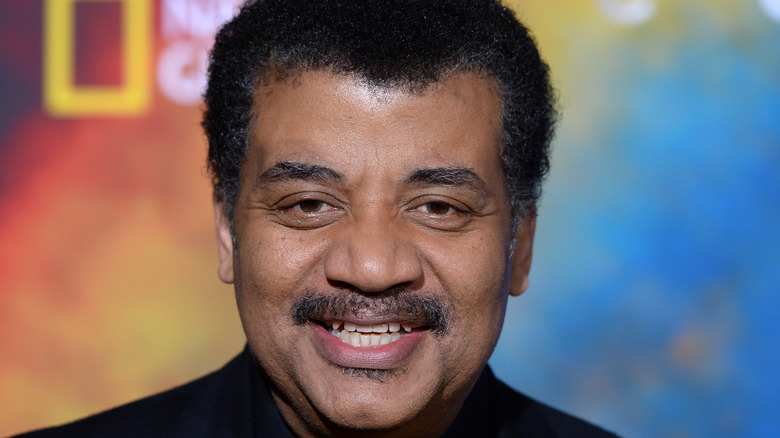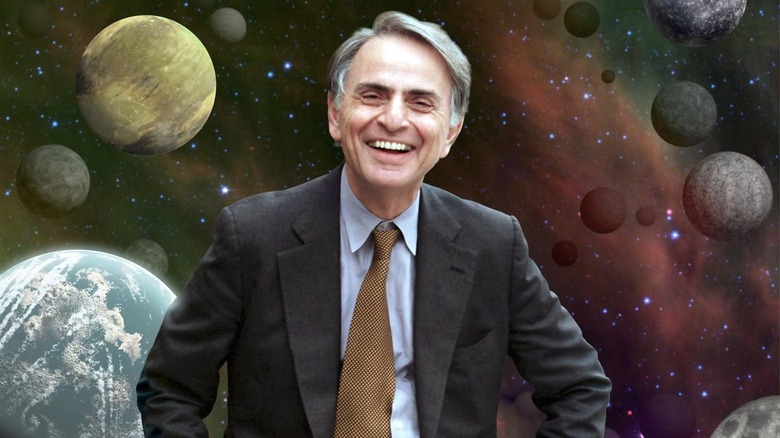The Space Icon That Influenced Neil deGrasse Tyson's Whole Life
If there is a voice that Americans, and perhaps the world, associate with the explanation of the mysteries of the universe, it is that of astrophysicist Neil deGrasse Tyson, a man who has dedicated his life to making science accessible to the general public. Dr. Tyson has served as the director of the prestigious Hayden Planetarium, part of the American Museum of Natural History, since 1996. He has written numerous books, essays, and professional publications, and has participated in mainstream televisions science shows (via Hayden Planetarium).
Dr. Tyson also caught the eye of the U.S. government. He served on a 12-member commission that studied the future of the American space industry, a position which President Bush appointed to Dr. Tyson in 2004. Two years later he served in another commission to study strategies for space exploration policies, something that was dubbed "Moon, Mars, and Beyond."
But how did a young man from New York, who graduated from the Bronx High School of Science and went on to attend Harvard and Columbia, have such an impact on the world of science? One of his most famous works is the television series "Cosmos: A SpaceTime Odyssey," and his fanbase may be interested to know that the series was a tribute to one particular space icon who had a major influence on his life.
Who was Dr. Carl Sagan?
When Dr. Tyson was just 17 years old, he met Dr. Carl Sagan. As Insider reports, Dr. Sagan responded to Neil deGrasse Tyson's application to Cornell with a personal letter inviting him to tour the campus and his own lab. The science icons would meet several times over the years. Dr. Tyson admits that since he first met Sagan, he felt compelled to extend the same courtesy and treatment to any student that approached him.
The lives of Dr. Tyson and Dr. Sagan draw many parallels. By bringing Sagan's "Cosmos" television series to the 21st century, Dr. Tyson continued his legacy. But, both scientists have even more in common, as they were both born in New York, both were avid astronomers and science writers (via Britannica), and both loved to share science with the world.
Dr. Sagan's views on science, politics, nuclear weapons, and extraterrestrial life stirred controversy, but by 1980 he was the best known American scientist. A graduate of physics with a doctorate in astronomy and astrophysics from the University of Chicago, Dr. Sagan became deeply involved in academic life. He served as a fellow at the University of California, Berkeley, worked at Harvard University, and was the director of Cornell University's Laboratory for Planetary Studies where he first met Neil deGrasse Tyson. Dr. Sagan also wrote the famous book "Contact" in 1985, which in 1997 was adapted for the big screen.
What Neil deGrasse Tyson said about Dr. Sagan
Neil deGrasse Tyson gave a eulogy for Carl Sagan in New York City on February 27, 1997, during a memorial service at the Cathedral of St. John the Divine. During the speech, Dr. Tyson passionately highlighted Sagan's work. "Collectively, all of us on this ship deliver lectures, write books, and give interviews with the media. But for each engagement, somehow we know that Carl had been there before — if not in person then in spirit," Dr. Tyson said.
Dr. Tyson also remembered his encounters and how Sagan influenced his public appearances. "I cannot count the number of times I have jump-started an encounter with the public by directly or indirectly referencing a jeweled quote from one of his many literary or media expositions on the universe," he added. The two met for the last time on Sagan's 60th birthday where they spent an evening celebrating among friends, colleagues, and family. During the celebration, many students gave testimony on how Sagan inspired them to pursue their dreams.
NASA explains that Dr. Sagan's work on Venus was not only groundbreaking but revealed that the planet's atmosphere was hot and dense. The space agency turned to him to select the landing sites for the first missions to Mars and help with the Viking probes. Dr. Sagan also discovered that Titan had ocean waters. The scientist is also known for designing the famous golden record NASA placed on Voyager 1 and 2. The record carried a message from Earth and humanity to extraterrestrial civilizations. Prior to the Voyager missions, Dr. Sagan designed a much simpler golden plaque that had the same objective: to establish first contact with alien civilizations.


